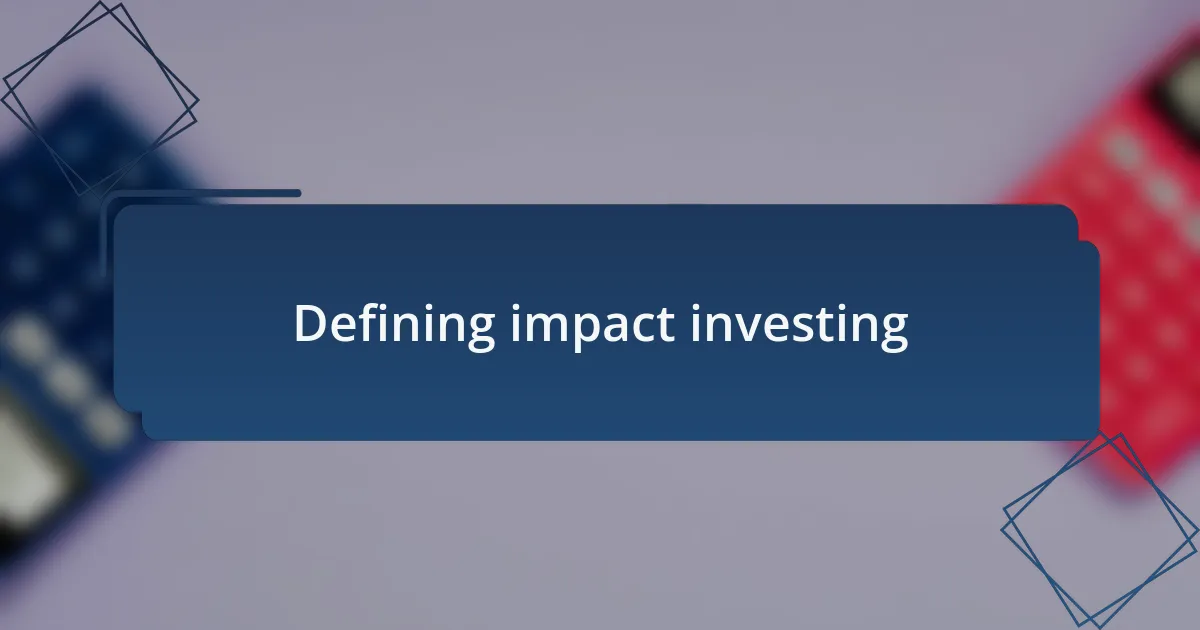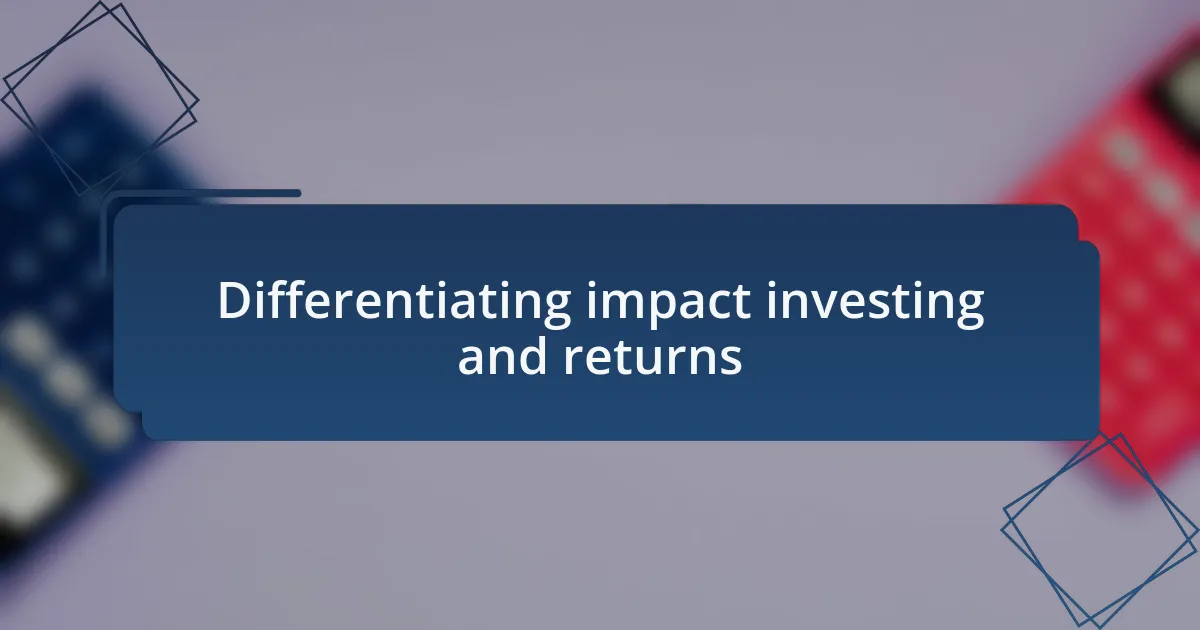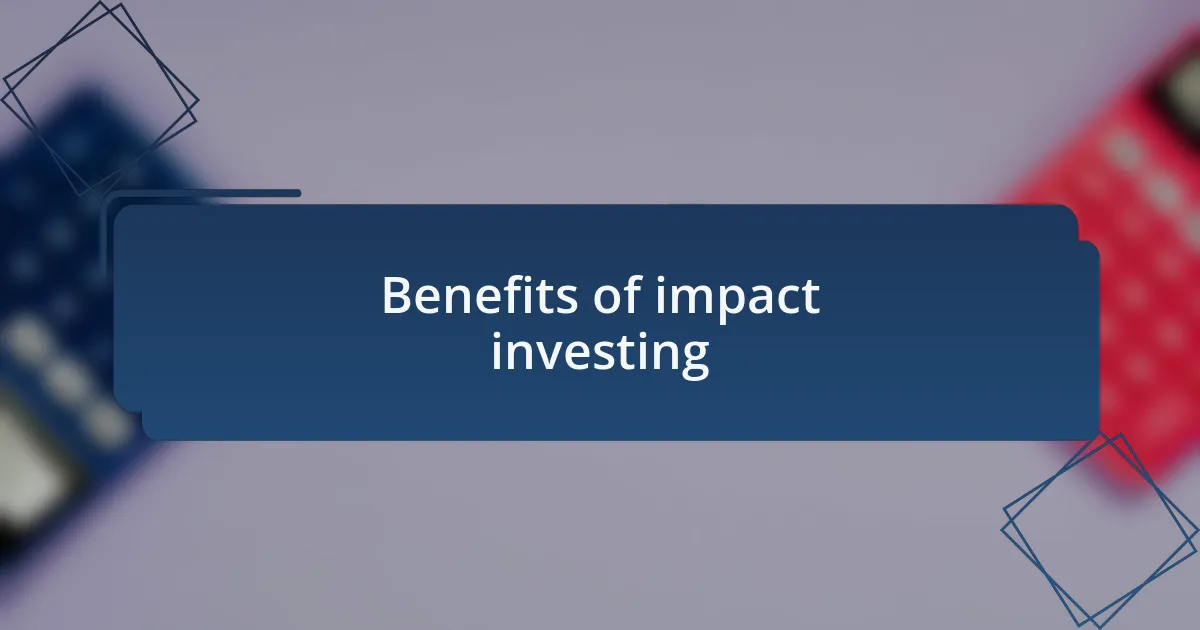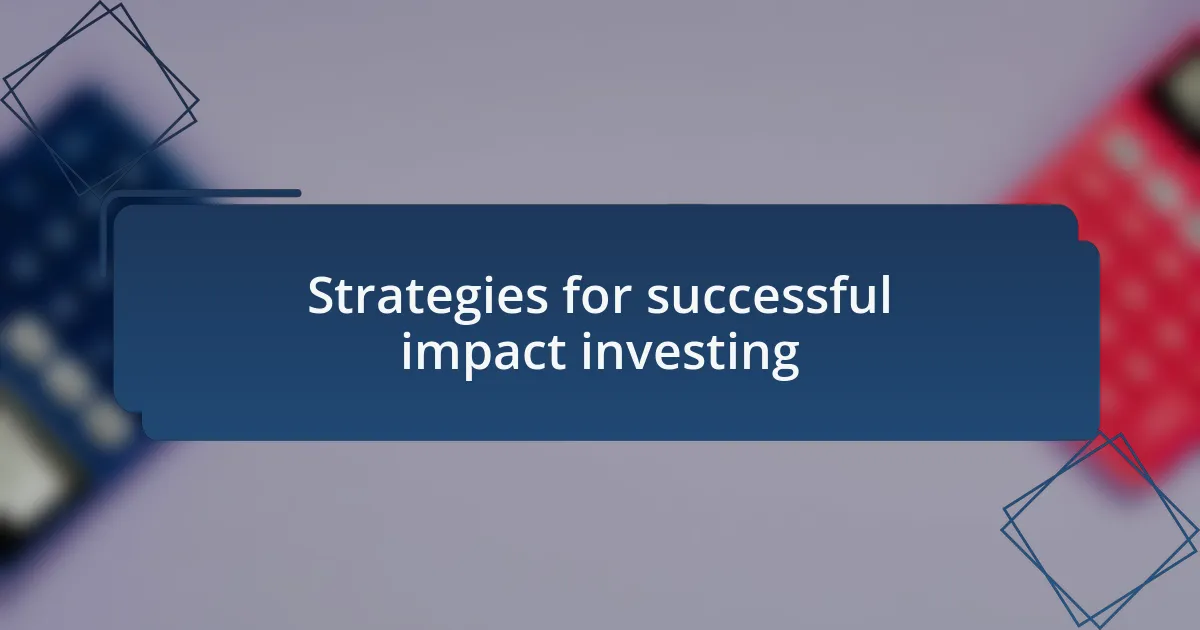Key takeaways:
- Eco-friendly finance aims to align financial activities with personal values, emphasizing the ecological impact alongside financial returns.
- Impact investing focuses on generating positive social and environmental outcomes while also seeking financial returns.
- Measuring success in impact investing involves assessing both financial metrics and the effects on community well-being and environmental sustainability.
- Strategies for successful impact investing include thorough research, setting clear goals, and networking within the impact investing community.

Understanding eco-friendly finance
Eco-friendly finance is a concept that goes beyond traditional investing; it’s about aligning your financial activities with your values. I remember when I first learned about green bonds — I was intrigued by how they allow investors to fund projects like renewable energy developments, which contribute positively to the environment. Isn’t it remarkable to think that money can not only grow but also help heal our planet?
At its core, eco-friendly finance means making conscious decisions that consider the ecological impact alongside financial returns. I often find myself reflecting on how my spending habits not only affect my portfolio but also the communities around me. When I choose sustainable companies, I’m not just investing; I’m voting for a better future with my wallet.
What truly excites me about this field is the innovative solutions emerging from eco-conscious finance. For instance, impact investing offers a chance to support environmental projects while potentially earning returns. Have you ever considered the idea that you can make a profit while actually contributing to solving climate issues? It’s a powerful mindset shift that challenges the status quo of finance.

Defining impact investing
Impact investing is about directing capital towards ventures that not only promise financial returns but also generate positive social and environmental outcomes. When I first explored this concept, it felt like a revelation that I could align my financial investments with the causes I care about deeply. Isn’t it inspiring to think that your money can actively contribute to community development or renewable energy solutions?
What distinguishes impact investing from traditional investments is its intention. While many invest purely for profits, impact investing is driven by a desire to create tangible benefits. I remember my first encounter with an impact fund focused on clean water initiatives. It struck me how a modest investment could help secure essential resources for communities in need. Isn’t it empowering to know that each dollar can help transform lives and ecosystems?
Furthermore, impact investments are often measured not just by financial returns, but by metrics like social profit or environmental sustainability. This dual focus on finance and impact really resonates with me; it invites investors to be mindful of their choices. Have you ever pondered how your investment decisions ripple through society? It’s a profound realization that leads to a more fulfilling investment journey, one where success is defined not just by financial gains, but by the positive change created along the way.

Differentiating impact investing and returns
When it comes to impact investing versus return-focused investing, the primary difference lies in the underlying motivation. Traditionally, investors might chase maximum financial returns without considering the broader implications of their capital allocation. I recall speaking with a friend who was solely focused on stock market performance, emphasizing profits with little regard for the underlying businesses’ societal impact. It made me wonder: could we not achieve both financial success and meaningful change?
The challenge with measuring success in impact investing is that it often requires a broader set of metrics. Financial returns are straightforward, often expressed in percentages. However, I find that assessing impact—like improvements in community health or environmental restoration—can be subjective and complex. It reminds me of an investment I made in a sustainable agriculture project; while the annual profits were decent, the real return came in the form of enhanced community well-being and reduced carbon footprint. How do you quantify that kind of success?
In my experience, the balance between generating returns and creating impact is a nuanced one. Sometimes, I’ve faced the dilemma of whether to go with an investment that promises higher financial returns but lacks positive social outcomes or a slightly lower return that champions environmental benefits. I often ask myself: is it worth chasing that extra percentage if the investment harms our planet? This internal debate leads to a richer and more responsible approach to investing, one that aligns financial returns with ethical considerations.

Benefits of impact investing
Impact investing offers a unique opportunity to align financial goals with positive societal outcomes. I remember the moment I invested in a renewable energy startup; not only did the company promise potential financial returns, but it also contributed to reducing reliance on fossil fuels. Seeing my investment directly support green energy initiatives gave me a sense of fulfillment that pure financial gains simply couldn’t match.
Another benefit of impact investing lies in fostering a sense of community and connection. I once participated in a local initiative that funded small businesses focused on sustainability. Witnessing the community thrive as these businesses flourished was incredibly rewarding, emphasizing that our capital could serve a greater purpose. Isn’t it gratifying to think that our investments can uplift communities while still providing financial benefits?
Moreover, impact investing can help mitigate risks associated with traditional investments. By supporting companies committed to sustainable practices, investors can often avoid pitfalls related to regulatory changes or market shifts towards green technologies. I’ve learned that choosing investments that prioritize environmental and social governance can often lead to more resilient portfolios. Can it be that aligning with eco-friendly practices is not just ethical but also strategically smart?

Strategies for successful impact investing
When it comes to successful impact investing, thorough research is essential. I recall diving deep into an environmentally focused fund. By understanding their business model, mission, and track record, I felt more confident that my money would go towards truly impactful initiatives rather than empty promises. What strategies do you use to gather information before investing?
Another effective strategy is to set clear goals regarding both financial returns and social impact. In my experience, defining the specific outcomes I wanted to achieve helped me screen potential investments effectively. For example, when I targeted funds supporting education in underserved communities, it gave me a focused approach that aligned with my values. Have you ever defined goals that guided your investment decisions?
Finally, networking within the impact investing community can lead to invaluable insights and opportunities. I remember attending a conference where passionate individuals shared their success stories, which inspired me to explore new avenues. Building relationships with like-minded investors not only expands your knowledge but can also lead to collaborative ventures that amplify positive outcomes. Isn’t it fascinating how community engagement can enhance our investment journeys?